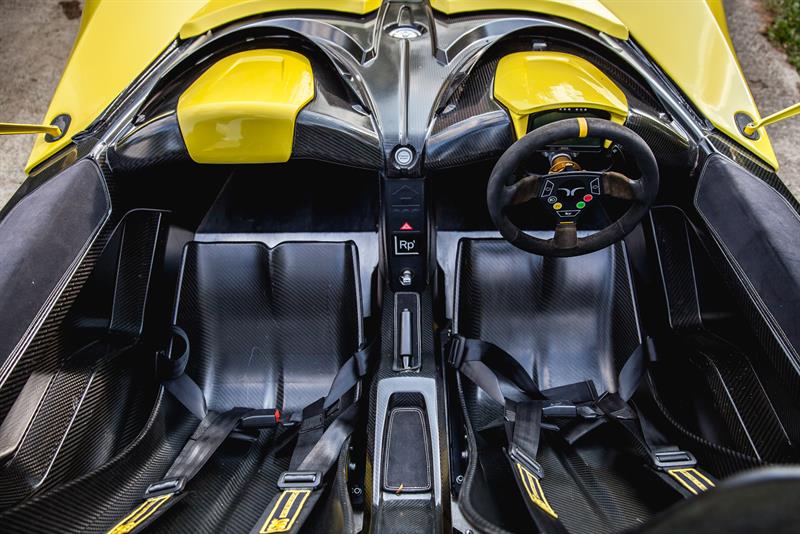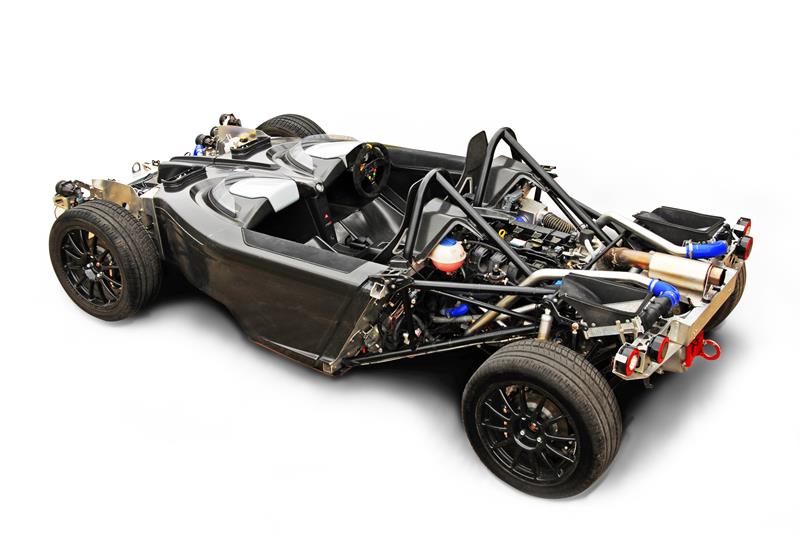Elemental kicked off in 2012 when former McLaren engineer John Begley set out on a quest to design and build the ultimate lightweight track day car that would also be road legal.
It was a notion that came to Begley when he was trying to buy himself a track day car and found during his test drives that every car was a compromise – there was always something in the design, the performance or the functionality that could be done better. And so he set out to try and do better.
His goal was to design a car that would be capable of driving to Le Mans, a car designed with F1/LMP inspired aerodynamics, cutting edge materials, modern powertrains, and built to the highest production standards. LMP (Le Mans Prototypes) require all the mechanics to be covered and are regarded as the fastest closed wheel cars.
Peter Kent, another ex-McLaren engineer who built up experience of composites working on the P1, has had a critical input into the design of the car. However, the use of advanced materials was always going to be a given. The fundamental design was not. “It’s all derived from the aerodynamics,” he said. “The aerodynamics has defined the seating position of this car and it turns out that it’s incredibly comfortable. So it actually made it quite hard for Guy [Colbourne], who’s done all the styling on the vehicle, because a lot of the time styling dictates and it can have a detrimental effect on the aerodynamics or the performance. But not with this one, performance comes first and then styling has to fit around that, whatever the cost.”
 Mark Fowler, co-founder of Elemental, brought his F1 experience of aerodynamics to the company. Introducing the novel seating position, otherwise only used in motorsport, needed some hard evidence if it was to become the starting point for the design. “I think the most elegant way to generate downforce is with the floor,” commented Fowler. “You don’t have any wings and aerofoils sticking out. It’s also very efficient because you’ve got a very large surface. The air’s going to go into the car anyway, so all we wanted to do was use it.So by putting the feet up, you can fit in a front diffuser and, by packaging the engine longitudinally, we can fit in a large rear diffuser.”
Mark Fowler, co-founder of Elemental, brought his F1 experience of aerodynamics to the company. Introducing the novel seating position, otherwise only used in motorsport, needed some hard evidence if it was to become the starting point for the design. “I think the most elegant way to generate downforce is with the floor,” commented Fowler. “You don’t have any wings and aerofoils sticking out. It’s also very efficient because you’ve got a very large surface. The air’s going to go into the car anyway, so all we wanted to do was use it.So by putting the feet up, you can fit in a front diffuser and, by packaging the engine longitudinally, we can fit in a large rear diffuser.”
More importantly it means the path the air takes can be started early and use the full length of the car, so the maximum amount of ‘work’ can be extracted from the air. This aerodynamic work is essential because the vehicle is so light (either 540kg or 580kg depending on the engine) and therefore not supplying enough intrinsic load on the tyres to provide grip while cornering at high speed would result in poor handling.
Essentially, said Fowler, it operates like an upside down wing with a splitter at the front of the car sending as much air as possible under the car. “The more air you put under there, the lower the pressure you get. Then, once you have that air, you want the big diffusers to extract work from it. By giving those diffusers as much air as possible, you maximise the amount of downforce they can generate. So that’s why it was conceived right from the start.”
More complex analysis was to follow as iterations of the concept developed. Such analysis required more sophisticated software and for this Elemental turned to LCS, a consultancy specialising in Computational Fluid Dynamics for high-end customers. Its CFD package, Fast, was used to refine the design of the RP1 – the name of the launch vehicle.
This is authentic, high-end technology,” said LCS’ CEO Mark Taylor. “Freeware was a useful tool initially, but no use if you want to get the type of performance these guys want. They have twice the downforce of any of their competitors. They definitely do have that, although some of their competitors are not so sure how. So as soon as you want to push the boundaries like that, you need the higher end tools to be sure of the accuracy, which is where we came in.
“The first thing we did was take the concept car to a wind tunnel to verify our CFD was right. Because CFD is a mathematical model, it has assumptions about turbulence. So the first thing we have to do is make sure that your mathematical model is correct. Having established that with data from the wind tunnel, we can do the next design with confidence.”
Using this tool it was possible to tune the aero balance on the front and rear axles, ensuring that the car behaved properly – no understeer or oversteer when it was operating at its limit. Taylor continued: “We can refine that based on what Mark [Fowler] understands from the mechanical side.So from the vehicle dynamics side you get the aero integrated with mechanical and the driver gets the optimum car behaviour.So before Elemental spent any money making carvings or designing the tooling, they know it’s going to work.”
Material matters
The original plan had been to build an aluminium frame and clad it with carbon or glass fibre bodywork. It took a long time to build so the company pulled on its experience of composites in Formula One and aerospace, and decided to make the central tub of carbon and bolt the front and rear chassis on to that. Kent said: “We were really pleased with the results on that and the torsional stiffness is phenomenal.”
The material is a prepreg carbon fibre material that is well proven in F1 and aerospace, but it comes at a cost. However, when Kent lookedfurther into the reason why it cost so much it revealed the material itself is not expensive at all, the costs come from the labour intensive methods in which parts are made.
Kent described how Elemental tackled the problem: “We developed processes that completely minimise that labour time. That’s how we’ve got the cost out of it, but still use the very high-tech material.”
That process was developed with a Portuguese company called Optimal Structural Solutions (OSS), who manufacture the tubs and all the composite bodywork.
OSS is run by another McLaren associate, Antonio Reis, who became involved when Elemental started to gear up towards production.
Kent said: “He’s known about this project from day one and he’s always done the stress analysis on the vehicle.He’s set up a tooling and composite manufacturing business in Portugal − he wanted to be part of this and we were really happy for him to be manufacturing the parts for us, it just seemed perfect.”
Taking the cost out of the moulding process essentially came down to making it very quick and easy to produce, by designing it in manageable pieces.
Rather than try and use a single sheet to make an entire moulding, a kit of plies in easy shapes is created. “If you’re clever about the way you split it up, it becomes incredibly easy to laminate a part,” said Kent.
There are actually four composite parts now in the tub – two side pods, the dash panel and the centre console – along with the aluminium floor and bulkheads.
Just about everything else on the vehicle is made within a 20-mile radius of the Elemental base in rural Hampshire. Even the engine comes from the Ford dealership in Portsmouth.
One departure in the material regime is the rear wheel arch, where Elemental is trialling a new carbon fibre composite from Coats Industrial. Processing it is a two part drill, different from the other moulding techniques.
“It’s not complicated once you’ve got the tooling,” said Kent. “There are initial tooling costs for this, but part cost is minimal. Because it’s a brand new process, we would look to start using it in other areas of the car.And also, unlike a lot of other new materials out there, you can keep 99% of the properties of the material.You can align the fibres in exactly the direction, and orientation, that you want them. It’s called tailored fibre placements.
“When we designed the tub, this material didn’t exist. We were approached by Coats and Shape Machining, who do work with us on this car. They approached us and said, ‘we’d like to trial a part on the car’. So we had a look around the vehicle and thought, right, what can we start with? This [the rear wheel arch] actually seemed perfect because it’s going to get a whole load of stuff thrown at it by the tyre and it’s got to be fairly stiff, because it’s linking one of the 200L luggage pods to the rear structure.”
The balance is delicate. Higher tooling costs against lower piece costs on account of the reduced manufacturing time. Potentially the material could be rolled out to all the other body parts of the car.
Roll out
The pre-production car made a successful debut in June doing the hill climb at the Goodwood 2016 Festival of Speed and the first production models have rolled off the assembly line since. But has it satisfied Begley’s original vision – a road/track high performance car with no compromises?
His response is confident: “It looks like it’s going to be unnerving to get in, but the controls and the feel of the car, just feels right. The performance is extreme, but you can work within that. It’s not hit the pedal and you go at a million miles an hour; it’s controllable.”
Rp1 Vital Statistics Width: 1775mm Length: 3740mm Height: 1070mm Ground clearance: 110mm (adjustable) Turning circle: 10.2m 1.0l Ecoboost Max speed: 145mph 0 - 60mph: 3.2sec 0 - 100mph: 7.8sec Power: 180bhp Weight: 540kg 2.0l Ecoboost Max speed: 165mph 0 – 60mph: 2.8sec 0 – 100mph: 6.4sec Power: 320bhp Weight: 580kg |
Want to find out more? Design manager Guy Colborne will be presenting at the Eureka! Conference during the Engineering Design Show, at 09.15 on 20th October. The actual Elemental Rp1 will be there to admire in the Innovation Zone. |











